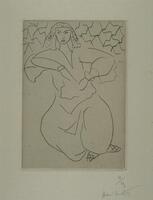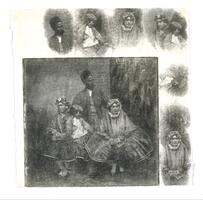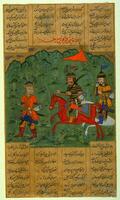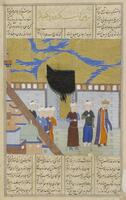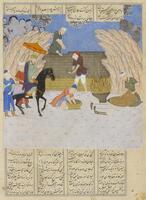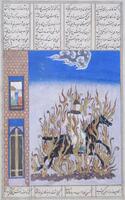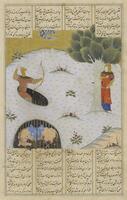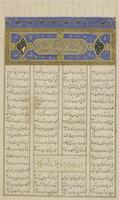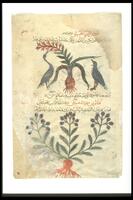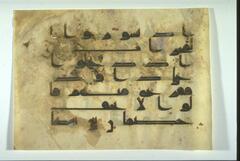10 Items in this Learning Collection
Collection Object
Collection Object
Collection Object
Collection Object
Collection Object
Collection Object
Copyright
All Rights Reserved
()
Sikandar Goes on a Pilgrimage to the Kaaba, from the Shahnama of Firdausi
Accession Number
1963/1.65
Title
Sikandar Goes on a Pilgrimage to the Kaaba, from the Shahnama of Firdausi
Artist(s)
Iranian
Artist Nationality
Iranian
Object Creation Date
circa 1460
Medium & Support
ink, opaque watercolor, and gold leaf on paper
Dimensions
10 1/2 in. x 7 in. ( 26.7 cm x 17.8 cm )
Credit Line
Museum Purchase
Label copy
Although today Mecca in Saudi Arabia is known worldwide as the destination of Islamic pilgrims from around the globe, its history as a holy place dates from very ancient times. It is the site of the Ka’aba, a rectangular brick shrine reputedly built by the Biblical Abraham (in Arabic and Persian, Ibrahim) and his son Ishmael (Isma’il). Muhammed was born and raised in Mecca, and made it one of the great centers of Islam; the first of the Islamic mosques, the great Al-Haram Mosque, surrounds the Ka’aba.
Here Sikander (Alexander) appears just outside the Ka’aba: he is the gray-haired and slightly stooped figure wearing a crown, while all his attendants wear turbans. The minaret at the upper left may allude to the Al-Haram Mosque, which is mentioned in Firdausi’s text, even though is it was erected centuries after Alexander’s time. Thus this episode, like the previous one, serves to fold Alexander into a unified and harmonious Persian-Islamic world.
Now in a little while, when all the troops
Were satiate of wealth, a sudden impulse
Came on Sikander, and he greatly longed
To journey to the Ka’aba. . . .
Sikander
Departed with his diadem and treasures
To look upon the house of Ibrahim,
Who bare no little toil to build that shrine,
Which God hath named Baitu’l Haram . . .
He visited afoot Baitu’l Haram;
The seed of Isma’il rejoiced in him.
At every step of Caesar’s* pilgrimage
His treasurer showered dinars.
Warner, VI, 119–21
* Caesar is used indiscriminately in the Shahnama to refer to rulers of western kingdoms. The use of this term and the epithet “Ruman” for Alexander in the previous episode remind readers of his Mediterranean origins, at the same time that the narrative content of the tale integrates him into Middle Eastern culture.
———
Maribeth Graybill, Senior Curator of Asian Art
Exhibited in "A Medieval Masterpiece from Baghdad: the Ann Arbor Shahnama"
August 14 through December 19, 2004
Subject matter
Sikandar Goes on a Pilgrimage to the Kaaba
Now in a little while, when all the troops
Were satiate of wealth, a sudden impule
Came on Sikandar, and he greatly longed
To journey to the Kaaba. So at dawn
The drum-roll rose...
Sikandar
Departed with his diadem and treasures
To look upon the house of Ibrahim,
Who bare no little toil to build that shrine,
Which God hath named Baitu'l Haram...
He visited afoot Baitu'l Haram;
The seed of Isma'il of Caesar's pilgrimage
His treasurer showered dinars.
Physical Description
This Persian miniature is attributed to the Shiraz and Timurid schools, ca. 1460. The painting is done in ink, opaque watercolor and gold leaf on paper. The scene, Sikandar Goes on a Pilgrimage to the Kaaba, is part of the Shahnama of Firdausi, the Persian book of kings.
Primary Object Classification
Painting
Primary Object Type
miniature
Collection Area
Western
Rights
If you are interested in using an image for a publication, please visit http://umma.umich.edu/request-image for more information and to fill out the online Image Rights and Reproductions Request Form. Keywords
Iranian Islamic painting styles after the Mongols
Iranian Islamic styles after the Mongols
Persian-Farsi (language)
Shahnama
Timurid
Timurid painting styles
gold leaf
gouaches (paintings)
miniatures (paintings)
shahs
watercolor painting (technique)
1963/1.65
Title
Sikandar Goes on a Pilgrimage to the Kaaba, from the Shahnama of Firdausi
Artist(s)
Iranian
Artist Nationality
Iranian
Object Creation Date
circa 1460
Medium & Support
ink, opaque watercolor, and gold leaf on paper
Dimensions
10 1/2 in. x 7 in. ( 26.7 cm x 17.8 cm )
Credit Line
Museum Purchase
Label copy
Although today Mecca in Saudi Arabia is known worldwide as the destination of Islamic pilgrims from around the globe, its history as a holy place dates from very ancient times. It is the site of the Ka’aba, a rectangular brick shrine reputedly built by the Biblical Abraham (in Arabic and Persian, Ibrahim) and his son Ishmael (Isma’il). Muhammed was born and raised in Mecca, and made it one of the great centers of Islam; the first of the Islamic mosques, the great Al-Haram Mosque, surrounds the Ka’aba.
Here Sikander (Alexander) appears just outside the Ka’aba: he is the gray-haired and slightly stooped figure wearing a crown, while all his attendants wear turbans. The minaret at the upper left may allude to the Al-Haram Mosque, which is mentioned in Firdausi’s text, even though is it was erected centuries after Alexander’s time. Thus this episode, like the previous one, serves to fold Alexander into a unified and harmonious Persian-Islamic world.
Now in a little while, when all the troops
Were satiate of wealth, a sudden impulse
Came on Sikander, and he greatly longed
To journey to the Ka’aba. . . .
Sikander
Departed with his diadem and treasures
To look upon the house of Ibrahim,
Who bare no little toil to build that shrine,
Which God hath named Baitu’l Haram . . .
He visited afoot Baitu’l Haram;
The seed of Isma’il rejoiced in him.
At every step of Caesar’s* pilgrimage
His treasurer showered dinars.
Warner, VI, 119–21
* Caesar is used indiscriminately in the Shahnama to refer to rulers of western kingdoms. The use of this term and the epithet “Ruman” for Alexander in the previous episode remind readers of his Mediterranean origins, at the same time that the narrative content of the tale integrates him into Middle Eastern culture.
———
Maribeth Graybill, Senior Curator of Asian Art
Exhibited in "A Medieval Masterpiece from Baghdad: the Ann Arbor Shahnama"
August 14 through December 19, 2004
Subject matter
Sikandar Goes on a Pilgrimage to the Kaaba
Now in a little while, when all the troops
Were satiate of wealth, a sudden impule
Came on Sikandar, and he greatly longed
To journey to the Kaaba. So at dawn
The drum-roll rose...
Sikandar
Departed with his diadem and treasures
To look upon the house of Ibrahim,
Who bare no little toil to build that shrine,
Which God hath named Baitu'l Haram...
He visited afoot Baitu'l Haram;
The seed of Isma'il of Caesar's pilgrimage
His treasurer showered dinars.
Physical Description
This Persian miniature is attributed to the Shiraz and Timurid schools, ca. 1460. The painting is done in ink, opaque watercolor and gold leaf on paper. The scene, Sikandar Goes on a Pilgrimage to the Kaaba, is part of the Shahnama of Firdausi, the Persian book of kings.
Primary Object Classification
Painting
Primary Object Type
miniature
Collection Area
Western
Rights
If you are interested in using an image for a publication, please visit http://umma.umich.edu/request-image for more information and to fill out the online Image Rights and Reproductions Request Form. Keywords
Iranian Islamic painting styles after the Mongols
Iranian Islamic styles after the Mongols
Persian-Farsi (language)
Shahnama
Timurid
Timurid painting styles
gold leaf
gouaches (paintings)
miniatures (paintings)
shahs
watercolor painting (technique)
